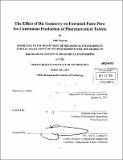The effect of die geometry on extruded paste flow for continuous production of pharmaceutical tablets
Author(s)
Nagaraj, Aditi
DownloadFull printable version (3.483Mb)
Other Contributors
Massachusetts Institute of Technology. Dept. of Mechanical Engineering.
Advisor
Jung-Hoon Chun.
Terms of use
Metadata
Show full item recordAbstract
The design of an extruder-based continuous tablet forming process of a sample active pharmaceutical ingredient (API) and ethyl acetate requires a device to form and compress the tablets. The flow of the wet extrusion is driven by the pressure head generated by the torque of the screws; the minimum pressure head is dictated by the head loss across the exit die. Since the API powder blend and ethyl acetate solvent form a highly filled suspension paste, the liquid phase tends to flow at a different speed than the solid when the driving pressure changes. As such, the three die geometries, straight, curve, and elbow, resulted in average steady state liquid mass fraction of 0.179 ± 0.005, 0.249 + 0.01, and 0.200 ± 0.009 respectively, although the increases in mass fraction do not correspond to increases in pressure drop across the die. This experiment tests a particular tablet forming process, which involves using the pressure of the extruder to squeeze out the liquid content of the tablets during forming. The occurrence of liquid phase migration after this tabletting process is confirmed in each die tested. The extent of variation in liquid content shows a 30% increase for the straight die, a 50-200% increase for the curve die, and 50-150% increase for the elbow die. These results suggest that a tablet forming device should not use the pressure of the extruder, due to the complications of paste flow.
Description
Thesis (S.B.)--Massachusetts Institute of Technology, Dept. of Mechanical Engineering, February 2011. "February 2011." Vita. Cataloged from PDF version of thesis. Includes bibliographical references (p. 33).
Date issued
2011Department
Massachusetts Institute of Technology. Department of Mechanical EngineeringPublisher
Massachusetts Institute of Technology
Keywords
Mechanical Engineering.